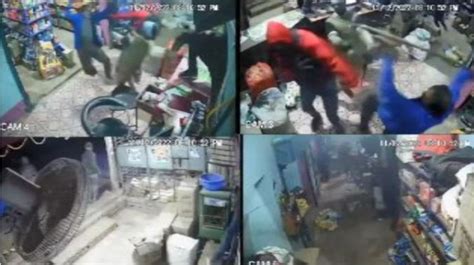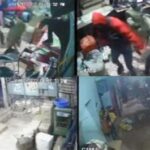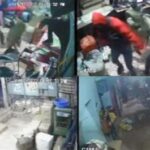
A brazen brawl inside a South Los Angeles store escalated into widespread looting, captured on surveillance footage released by the Los Angeles Police Department (LAPD). The incident, which occurred on June 3, 2024, involved a large group of individuals who initially engaged in a physical altercation before ransacking the establishment.
Los Angeles police are seeking the public’s help in identifying those involved in the incident, which took place at a retail location in the 77th Division. According to the LAPD, the fight broke out between multiple suspects inside the store. The situation quickly deteriorated as participants began stealing merchandise, resulting in significant property loss for the business.
“The initial call came out as a fight inside of a business,” said LAPD Officer Mike Lopez. “As officers were responding, the call was updated to a looting in progress.”
Surveillance footage shows numerous individuals grabbing items off shelves, filling bags, and running out of the store. The video also depicts the initial fight, with people throwing punches and pushing each other amidst the aisles. The chaotic scene highlights the speed with which the situation devolved from a simple altercation to a large-scale looting event.
The LAPD is actively investigating the incident and is urging anyone with information to come forward. They have released the surveillance footage to local news outlets and are sharing it on social media platforms in an effort to identify the suspects. The police department emphasizes the severity of the crime and its commitment to bringing those responsible to justice.
“We are working diligently to identify and apprehend the individuals involved in this looting,” stated Officer Lopez. “Such behavior will not be tolerated, and we will pursue every avenue to ensure they are held accountable.”
The incident has sparked concern among local business owners and residents, who fear a rise in similar criminal activities. Community leaders are calling for increased security measures and greater cooperation between law enforcement and the public to prevent future occurrences. The LAPD has assured the community that they are increasing patrols in the area and working closely with local businesses to enhance security protocols.
The financial impact of the looting is still being assessed, but preliminary estimates suggest that the store suffered significant losses. The cost of stolen merchandise, along with damages to the property, is expected to be substantial. The incident also raises questions about the potential long-term effects on the business, including potential closures or reduced operating hours.
The LAPD is asking anyone with information about the incident or the identities of the individuals involved to contact the 77th Division Detective Desk. Tips can be submitted anonymously, and the police department assures that all information will be treated with the utmost confidentiality.
The incident underscores the challenges law enforcement faces in maintaining order and preventing crime in urban areas. It also highlights the importance of community involvement in addressing criminal activity and ensuring the safety and security of local businesses and residents.
Expanded Context and Analysis:
The looting incident in South Los Angeles reflects a broader trend of retail crime and organized theft that has been plaguing cities across the United States. Several factors contribute to this trend, including economic disparities, social unrest, and changes in law enforcement policies. Understanding these factors is crucial to developing effective strategies for preventing and addressing such incidents.
Economic Disparities:
Economic inequality and poverty can create an environment where individuals are more likely to engage in criminal activities. In communities with high unemployment rates and limited access to resources, the temptation to steal or loot may be greater. The economic hardship caused by the COVID-19 pandemic has exacerbated these disparities, leading to increased desperation and, in some cases, criminal behavior.
South Los Angeles, in particular, has historically faced significant economic challenges. The area has a higher poverty rate and lower median income compared to the city as a whole. These economic conditions can contribute to a sense of frustration and disenfranchisement, which may manifest in acts of violence and looting.
Social Unrest:
Social unrest and protests, while often peaceful, can sometimes create opportunities for criminal elements to engage in looting and property damage. The atmosphere of chaos and disorder can embolden individuals to take advantage of the situation and commit crimes they might not otherwise consider. The recent increase in social activism and protests related to issues such as racial injustice and police brutality has, in some instances, been accompanied by incidents of looting and rioting.
It is important to note that the vast majority of protesters are peaceful and law-abiding. However, a small minority may use protests as a cover for criminal activity. Law enforcement agencies must be prepared to respond effectively to these situations while respecting the rights of peaceful protesters.
Changes in Law Enforcement Policies:
Some critics argue that changes in law enforcement policies, such as bail reform and reduced penalties for certain crimes, have contributed to an increase in retail crime. They contend that these policies have created a perception that there are fewer consequences for theft, leading to a rise in shoplifting and looting.
However, others argue that these policies are necessary to address systemic issues in the criminal justice system, such as mass incarceration and racial bias. They maintain that reducing penalties for non-violent crimes can help to alleviate overcrowding in prisons and reduce the disproportionate impact of the criminal justice system on minority communities.
The debate over law enforcement policies is complex and multifaceted. There is no easy answer to the question of whether these policies have contributed to an increase in retail crime. However, it is important to consider all sides of the issue when developing strategies for addressing this problem.
Organized Retail Crime:
In many cases, looting and retail theft are not spontaneous acts of desperation but rather organized criminal enterprises. These groups coordinate their activities, target specific stores, and resell stolen merchandise for profit. Organized retail crime can be highly sophisticated, involving multiple individuals and complex logistical operations.
The rise of online marketplaces has made it easier for organized retail crime groups to sell stolen merchandise. These platforms provide a convenient and anonymous way to reach a large number of potential buyers. Law enforcement agencies are working to crack down on organized retail crime by targeting the leaders and organizers of these groups and by working with online marketplaces to identify and remove stolen merchandise.
Impact on Local Businesses:
Looting and retail theft can have a devastating impact on local businesses. The cost of stolen merchandise, property damage, and increased security measures can be substantial. In some cases, businesses may be forced to close down or relocate, leading to job losses and economic decline in the affected communities.
Small businesses are particularly vulnerable to the impact of looting and retail theft. These businesses often have limited resources and may not be able to afford the cost of increased security measures. They may also be less likely to have insurance coverage for theft and property damage.
The incident in South Los Angeles serves as a stark reminder of the challenges faced by local businesses in urban areas. It is essential for law enforcement agencies, community leaders, and residents to work together to create a safe and secure environment for businesses to thrive.
Community Response:
The community response to the looting incident in South Los Angeles has been one of concern and outrage. Residents and community leaders have condemned the violence and called for greater efforts to prevent future incidents. Many have expressed support for the affected business and offered assistance in cleaning up and repairing the damage.
Community organizations are working to address the underlying issues that contribute to crime and violence in the area. These efforts include providing job training and educational opportunities, promoting economic development, and fostering positive relationships between law enforcement and the community.
The involvement of the community is crucial to addressing the problem of looting and retail theft. By working together, residents, businesses, and law enforcement agencies can create a safer and more prosperous environment for all.
LAPD’s Strategy and Challenges:
The LAPD faces significant challenges in addressing looting and retail theft. The department must balance the need to maintain order and prevent crime with the rights of individuals to protest and express their opinions. The LAPD must also work to build trust and positive relationships with the community, particularly in areas with a history of tension between law enforcement and residents.
The LAPD has implemented several strategies to address looting and retail theft, including:
- Increased patrols in high-crime areas
- Collaboration with local businesses to enhance security measures
- Targeting organized retail crime groups
- Working with online marketplaces to identify and remove stolen merchandise
- Engaging with the community to build trust and foster positive relationships
Despite these efforts, the LAPD continues to face challenges in preventing and addressing looting and retail theft. The department is constantly adapting its strategies to meet the evolving nature of crime and to address the underlying issues that contribute to criminal behavior.
Legal Consequences and Penalties:
The legal consequences for individuals involved in looting and retail theft can vary depending on the severity of the crime and the jurisdiction in which it occurs. In general, looting is considered a form of theft and can be charged as either a misdemeanor or a felony.
Factors that can influence the severity of the charges include:
- The value of the stolen merchandise
- Whether the theft was committed during a state of emergency or civil unrest
- Whether the individual has a prior criminal record
- Whether the individual used force or violence during the theft
In California, looting is typically charged as grand theft if the value of the stolen merchandise exceeds $950. Grand theft is a felony offense that can carry a sentence of up to three years in state prison. Looting committed during a state of emergency or civil unrest can be subject to enhanced penalties.
Individuals convicted of looting may also be required to pay restitution to the affected businesses and may face civil lawsuits for damages.
Preventative Measures for Businesses:
Businesses can take several steps to prevent looting and retail theft, including:
- Installing security cameras and alarm systems
- Hiring security guards
- Training employees on how to respond to theft and suspicious behavior
- Keeping valuable merchandise in secure locations
- Working with other businesses to share information and coordinate security efforts
- Improving lighting and visibility in and around the store
- Implementing inventory control measures to track merchandise and identify losses
- Establishing a relationship with local law enforcement agencies
By taking these preventative measures, businesses can reduce their risk of becoming a target for looting and retail theft.
The Role of Social Media:
Social media can play a significant role in both facilitating and addressing looting and retail theft. On the one hand, social media platforms can be used by organized crime groups to coordinate their activities and recruit participants. Social media can also be used to spread misinformation and incite violence.
On the other hand, social media can also be used by law enforcement agencies to identify suspects, gather evidence, and communicate with the public. Social media can also be used by community members to share information, organize support for affected businesses, and condemn criminal behavior.
It is important for social media platforms to take steps to prevent their platforms from being used to facilitate looting and retail theft. This includes monitoring content for illegal activity, removing posts that incite violence, and cooperating with law enforcement agencies.
Long-Term Solutions:
Addressing the problem of looting and retail theft requires a comprehensive and multi-faceted approach. In addition to law enforcement efforts, it is essential to address the underlying issues that contribute to crime and violence, such as economic disparities, social unrest, and lack of opportunity.
Long-term solutions include:
- Investing in education and job training programs
- Promoting economic development in underserved communities
- Addressing systemic issues of inequality and discrimination
- Fostering positive relationships between law enforcement and the community
- Providing support services for individuals struggling with poverty, addiction, and mental health issues
- Strengthening community bonds and promoting social cohesion
By addressing these underlying issues, we can create a more just and equitable society where individuals are less likely to engage in criminal behavior.
The incident in South Los Angeles serves as a reminder of the complex challenges facing urban communities. By working together, we can create a safer and more prosperous environment for all.
Frequently Asked Questions (FAQ):
- What exactly happened at the store in South Los Angeles? A fight broke out among a group of individuals inside a retail store, which then escalated into widespread looting. Surveillance footage shows people stealing merchandise and fleeing the scene.
- When did this incident occur? The incident occurred on June 3, 2024.
- What is the LAPD doing about this incident? The LAPD is actively investigating the looting, seeking public assistance to identify the individuals involved. They have released surveillance footage and are increasing patrols in the area.
- What can I do if I have information about the looting? Anyone with information is urged to contact the 77th Division Detective Desk of the LAPD. Tips can be submitted anonymously.
- What are the potential consequences for those involved in the looting? The legal consequences can vary, but looting is considered a form of theft and can be charged as either a misdemeanor or a felony, potentially leading to jail time, fines, and restitution to the affected business. The penalties can be enhanced if the looting occurred during a state of emergency.









